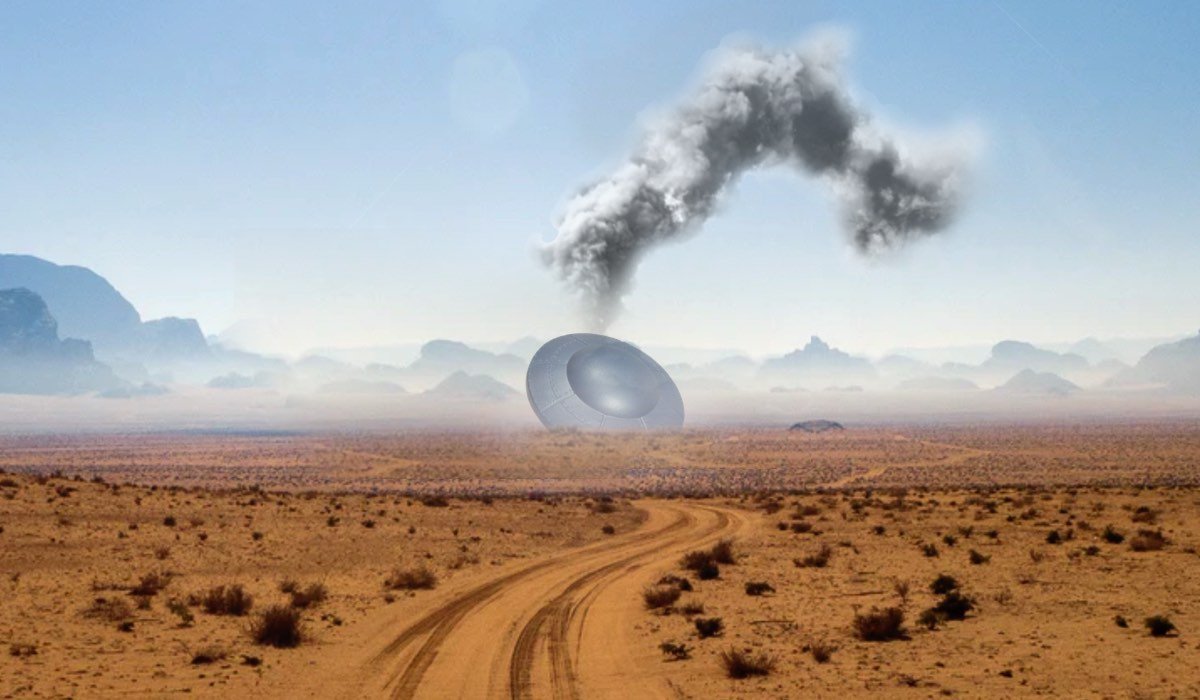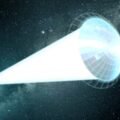On July 8, 1947, an unusual front-page headline captured the attention of residents throughout southeastern New Mexico.
“RAAF Captures Flying Saucer On Ranch in Roswell Region” read the story that appeared in the Roswell Daily Record that morning. Though offering few specifics about the purported craft, the article went into detail how the 509th Bombardment group at Roswell Army Air Field had retrieved the “instrument” which was thereafter flown to “higher headquarters.”
Just one day later, the Record would publish a follow-up to the alarming story, which now stated that an army investigation, under the direction of Gen. Roger M. Ramey, commander of the Eighth Air Forces, had solved the mystery. The object, the Record stated, “was a harmless high-altitude weather balloon—not a grounded flying disc.”
Despite the official explanation presented at the time, the story of an alleged flying saucer crash at Roswell, New Mexico—one that now celebrates its 75th anniversary—would later go on to claim legendary status in the annals of popular American UFO lore.
The main events in what would become the saga of the Roswell incident actually began in mid-June 1947, when rancher Mac Brazel made the discovery of odd-looking wreckage scattered across his remote New Mexico ranch property. With no access to a telephone or radio while at the ranch, Brazel had been unaware at the time he visited the nearby town of Corona on July 5 that the United States was in the middle of a wave of sightings of mysterious aerial objects, which the press had recently dubbed “flying saucers.”
The sensation surrounding mysterious flying discs had taken off more than a week earlier on June 26, after pilot Kenneth Arnold reported his sighting of a series of strange flying objects he watched fly erratically over Mount Rainier, Washington. Once Brazel made his way into Corona that Saturday evening and began to learn of the news, he began to wonder if the debris he had found might somehow be connected with the saucer sightings reportedly occurring across the nation.
Brazel decided to contact authorities in Roswell about his find, and on July 7, he brought some of the wreckage to Sheriff George Wilcox, who thereafter reached out to the nearby Roswell Army airbase. Soon Jesse Marcel, the base intelligence officer, was dispatched to accompany Brazel back to his ranch to search for more of the mysterious debris.
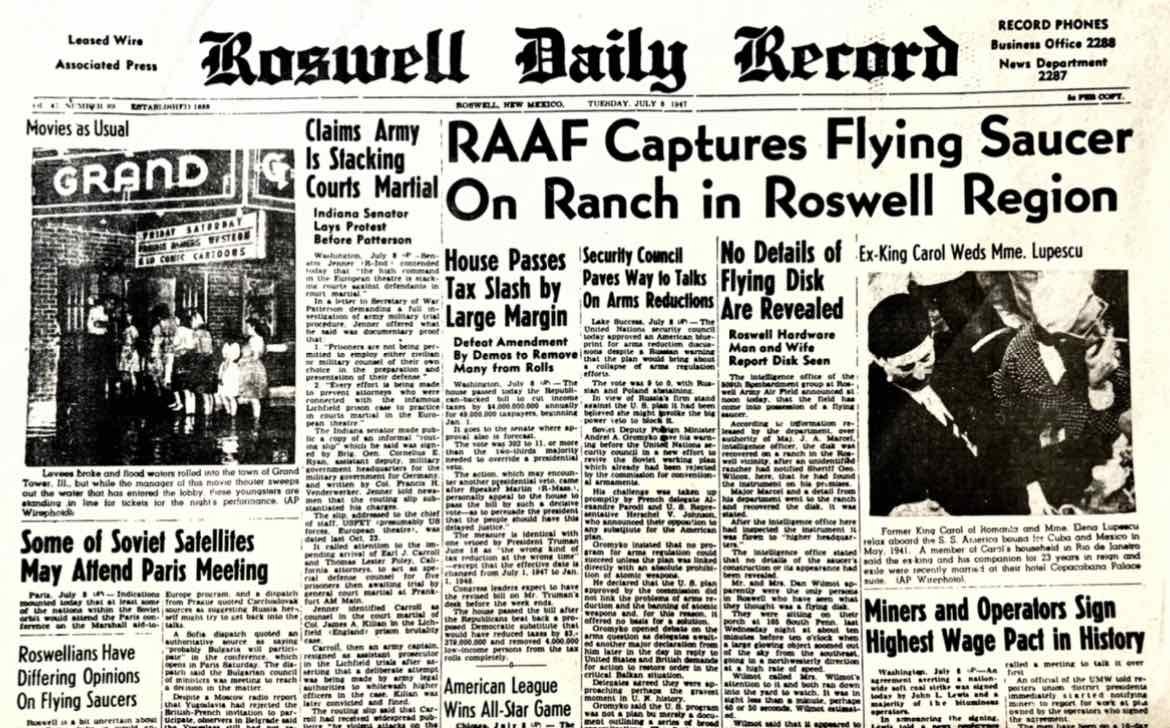

On July 8, 1947, the front page of the Roswell Daily Record carried the unusual story about the purported capture of a flying saucer. This was followed just one day later by an update, which now reported that the alleged disc had been identified as being merely a weather balloon.
Following the Army’s official explanation, interest in the Roswell incident fell away, and for decades there was barely any attention paid to the story. In his 1967 Report on the UFO Wave of 1947, researcher Ted Bloecher even included the incident in a section titled “Hoaxes and Mistakes,” in which he wrote that “One of those mistakes, given the widest possible publicity, had its origins near Roswell, New Mexico,” adding that “Through a series of clumsy blunders in public relations, and a desire by the press to manufacture a crashed disc if none would obligingly crash of itself, the story got blown up out of all proportions.”
The Roswell Incident Rises From the Ashes
However, attitudes toward the Roswell story would begin to change in the late 1970s, when civilian UFO researchers Stanton Friedman and William Moore managed to track down several of the original witnesses. Among these had been Jesse Marcel, who provided additional details about the incident, thus breathing new life into a once-forgotten chapter in flying saucer history. The coup de grace, however, had been the 1980 publication of The Roswell Incident, coauthored by Moore and popular American writer Charles Berlitz, which solidified the incident in the public mind as one of the most credible purported UFO crash stories ever uncovered.
With time, and with the help of several similar popular books that followed, it also became what is undoubtedly recognized as the most famous alleged UFO incident of the 20th century.
Today, as Roswell celebrates its 75th anniversary, the story still manages to captivate the American public. This, despite a pair of official U.S. Air Force reports–one issued in 1994, the other in 1997–that asserted the 1947 incident had resulted from a then-top-secret high-altitude balloon project undertaken by the Army Air Forces that began the same year and lasted until the early weeks of 1949.
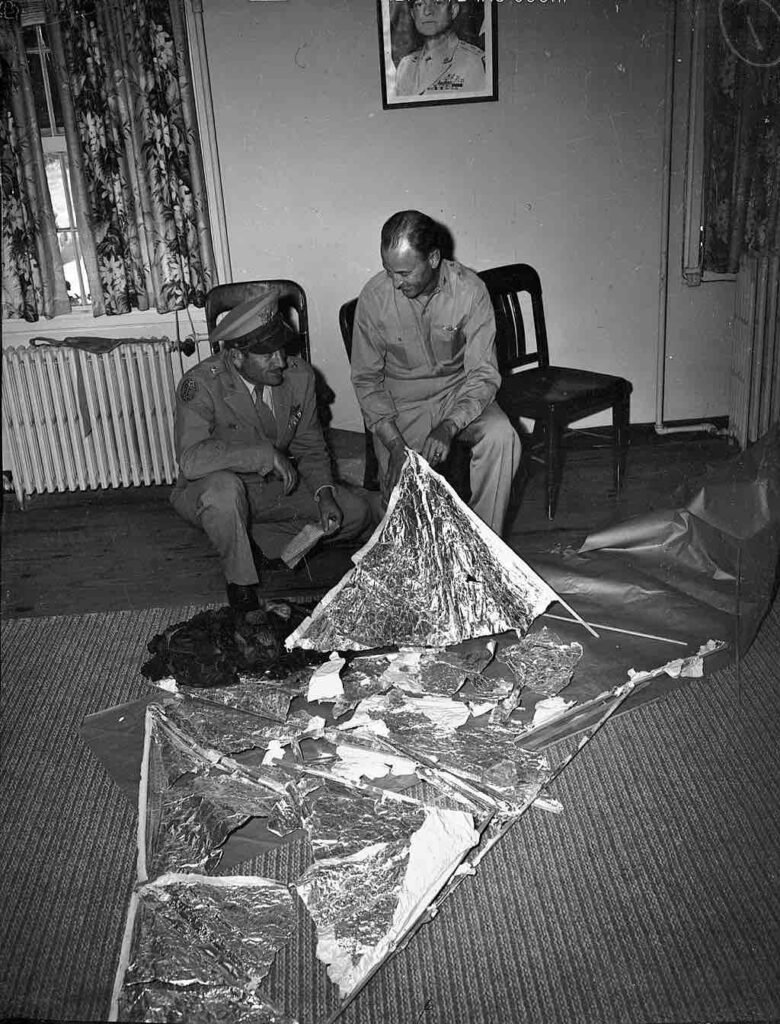

“The 1994 Air Force report concluded that the predecessor to the U.S. Air Force, the U.S. Army Air Forces, recovered debris from an Army Air Forces balloon-borne research project code named MOGUL,” reads a portion of an executive summary from the U.S. Air Force report. “Records located describing research carried out under the MOGUL project, most of which were never classified (and publicly available) were collected, provided to [the Government Accountability Office], and published in one volume for ease of access for the general public.”
The 1994 report also attempted to explain stories about the alleged recovery of alien bodies at the time of the incident. “Contrary to allegations, many of the accounts appear to be descriptions of unclassified and widely publicized Air Force scientific achievements,” a portion of the report stated, noting that other descriptions associated with purported alien bodies “appear to be actual incidents in which Air Force members were killed or injured in the line of duty.”
The Air Force explanation seemed plausible, especially on account of materials in the original 1947 press photos which appeared to include bits of foil and other materials consistent with balloons and radar reflectors, the likes of which the Mogul units consisted of. However, critics of the new “official” explanation were quick to point out that the story had already been changed from a flying saucer to a weather balloon once before, and now the explanation had been changed again with the Mogul story. The military had effectively admitted that it lied to cover up a classified project in 1947, so how could anyone be sure the Mogul story wasn’t just more of the same?
To this day, opinions remain divided on what precisely happened in the New Mexico desert in the summer of 1947. However, one important factor is often missing from discussions about Roswell: this involves how the legend of a UFO crash somewhere in the American desert had been nothing new by the time the 1947 incident first came to widespread public attention.
Crashed Spaceships: An American Tradition
What is likely to be the earliest instance involving the alleged crash of a mysterious aircraft in America was reported in the Daily Nebraska State Journal on June 6, 1884. The incident, said to have occurred in southwestern Nebraska near the town of Benkelman, was witnessed by a group of cowboys in Dundy County, who thereafter discovered scraps of metal machinery scattered across the nearby prairie. It was also reported that the cowboys were prevented from investigating the site due to the intense heat at the site of the crash. Curiously, it was reported days later that during a tremendous rain, the “queer object had melted, dissolved by the water like a spoonful of salt.” Decades later in 1927, it was revealed that the stories had been a hoax that, according to Patricia C. Gaster, was “created in the fertile brain of James D. Calhoun, then managing editor.”
Again in 1897, a year that was rife with reports of mysterious airships over the United States, a similar tale involving a purported crash of a mysterious flying vehicle was logged near Aurora, Texas. In the case of the Aurora airship crash, a new dimension was added to this budding new motif in American folklore: within the mysterious wreckage, the body of the airship’s pilot was also recovered, and reportedly buried at a nearby cemetery.
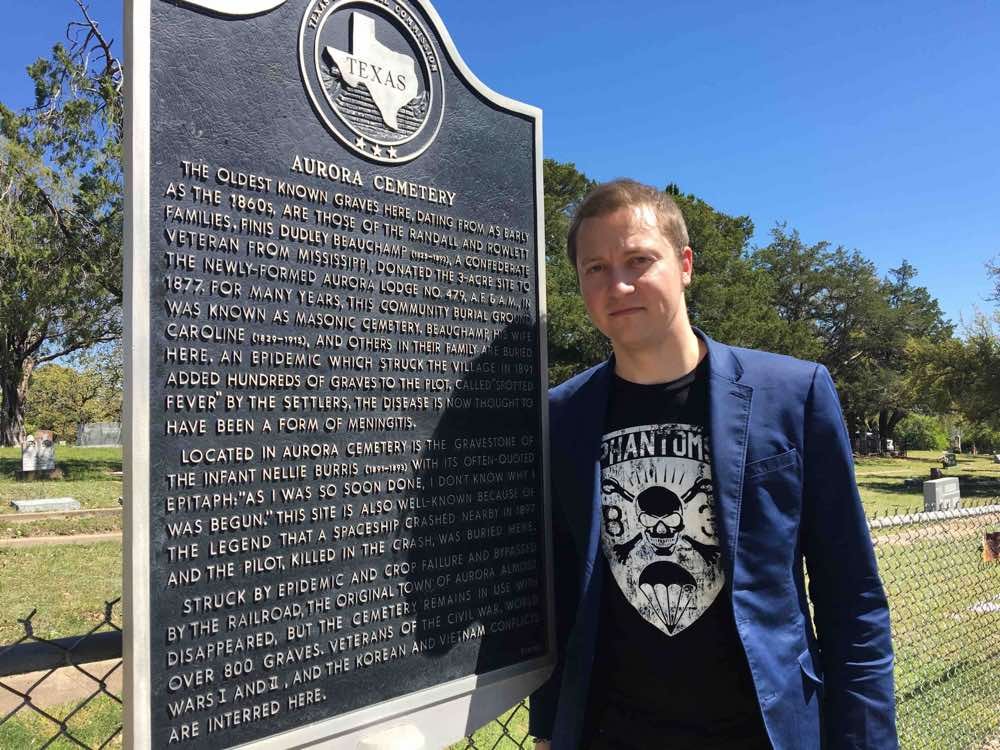

While both of these stories rank among the common newspaper hoaxes of the era, they are significant on account of the similarity they share with later instances involving alleged crashes of alien spaceships that would begin to emerge in the early years of flying saucer madness that swept the United States in the 1940s and 50s.
Just two years after the Roswell incident made headlines in 1947, Frank Scully, then a columnist for Variety, first wrote about an alleged flying saucer crash he learned of that occurred in 1948 at Aztec, New Mexico. The story was later part of the basis for a book Scully published, Behind the Flying Saucers, in 1950.
Although the Aztec UFO crash story was exposed as an elaborate hoax in a 1954 True expose, various attempts to revive the story have occurred over the years, particularly after the 2013 release of an FBI memorandum, dated March 22, 1950, which made references to the purported crash. The document, now referred to as “The Guy Hottel Memo”, has been cited by the Bureau as “The most popular file in the FBI Vault.”
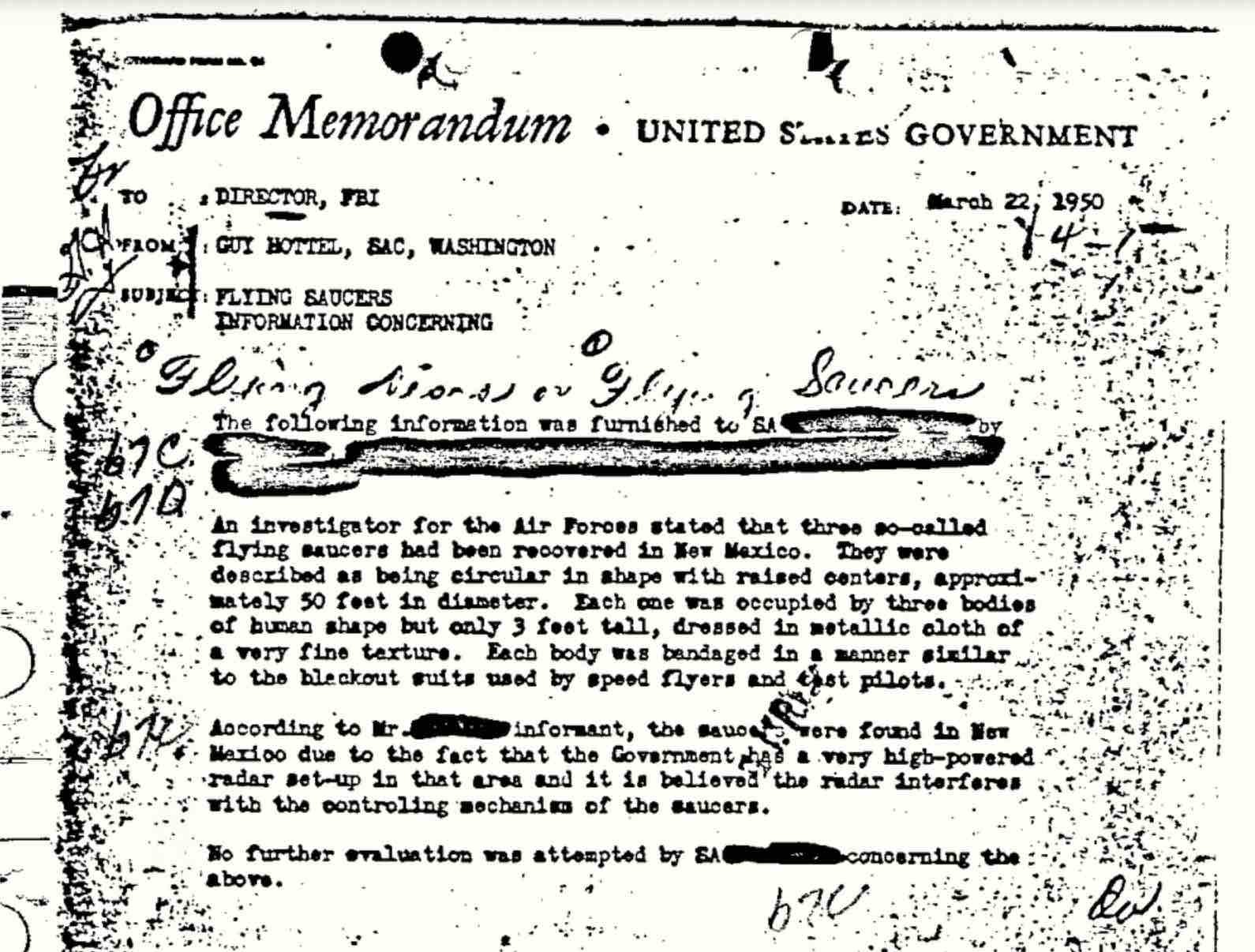

During the late 1970s, around the same time that Stanton Friedman, William Moore, and others were beginning to revive the Roswell story, UFO researcher Leonard Stringfield had been assembling information he collected over the years that also related to claims of UFO crashes. The culmination of this research would be a series of “Status Reports” independently published by Stringfield, which documented several alleged UFO crashes that occurred over the years. One of these, according to a former helicopter pilot and Army Warrant Officer Stringfield spoke with in 1977 after a lecture he had given on the topic, occurred in Arizona in 1953 and bore remarkable similarities to the Roswell story that would reemerge just three years later.
“I had seen the bodies,” the retired officer told Stringfield, explaining that they had arrived at Wright Patterson AFB (then called Wright Field) where he had been on duty. The pilot told Stringfield he had been employed there as an engineer at the time, and claimed to have witnessed the arrival of three small humanoids packed in dry ice. Each was approximately four feet tall, and possessed disproportionately large eyes, hands, and wore tight-fitting dark-colored suits.
A Tale of Two Crashes: Reconciling the Roswell Stories
The description of the alien bodies given to Stringfield in 1977 is obvious in its similarity to later descriptions of the purported alien bodies recovered at the Roswell crash site. Curiously, although Moore and Berlitz’s 1980 book mentioned an alleged observation of alien bodies by one Grady L. “Barney” Barnett, this element had not been a central focus of their analysis, which had been largely critical of earlier claims of UFO crashes like the Aztec incident promoted by Frank Scully.
In 1990, Gerald Anderson, a Missouri-based security guard, contacted researchers Stanton Friedman and Kevin Randle with claims that he had been present in 1947 at the time of Barnett’s sighting. Randle, who later went on to co-author the book UFO Crash at Roswell with researcher Donald Schmitt the following year, expressed reservations about Anderson’s claims. By contrast, Friedman, who accompanied Anderson on a trip to what he claimed had been the crash site, reported that Anderson also passed a polygraph test, showing “no evidence of deception.”
It was now apparent that there were conflicting perspectives on the Roswell incident, and by September 1991, an effort was underway by the Center for UFO Studies in cooperation with the Fund for UFO Research at attempting to resolve the issue. The result was The Plains of San Agustin Conference (also referred to as “Crash III”), a conference held in Chicago on February 15-16, 1992, where researchers met to attempt to resolve the fragmented Roswell narratives (a summary report on the proceedings of that conference can be read here).
The Roswell Legacy
After three-quarters of a century, the Roswell story continues to garner attention both from skeptics and UFO proponents. The Mogul balloon scenario remains the U.S. Air Force’s official stance, and is generally the most widely accepted explanation for the 1947 incident, although some longtime UFO investigators maintain alternative perspectives.
In April 2021, I asked longtime Roswell researcher Kevin Randle what his response would be to those who argue there is little substantive evidence to support an extraterrestrial conclusion regarding the 1947 Roswell incident.
“I would say absolutely,” Randle told me. “You’re correct, we don’t have the debris.”
“What we have is testimony from very reliable people,” Randle went on to explain. “We have documentation that something happened. Everyone agrees something fell. The question is, what was it?”
Randle, while acknowledging that there is not enough evidence to conclude that the crash of an extraterrestrial craft occurred in New Mexico in 1947, also challenges the more widely accepted Mogul theory, saying that equal scrutiny should be put toward inconsistencies that arise from this proposed solution to the 1947 incident.
“The question I ask them, in turn, is you say it’s Project Mogul, where is the documentation? The documentation says the launch never took place,” Randle said. “It never flew. Ergo, it cannot be Project Mogul.”
“What are you left with? Absolutely nothing,” Randle said.
Today, the small New Mexico town is recognized as a sort of Mecca for those seeking answers to the enduring mystery of unexplained aerial phenomena. Every July, Roswell hosts its very own UFO Encounter Festival, which sees attendance by visitors from around the world.
Perhaps what remains the clearest about the Roswell incident today, seventy-five years after it first made headlines, is that the debate over what happened in the New Mexico desert in 1947 remains very much alive. Without a doubt, opinions over one of history’s greatest UFO controversies remain as diverse—and as divided—as they have ever been, and likely will remain so for some time to come.
Micah Hanks is Editor-in-Chief and Co-Founder of The Debrief. Follow his work at micahhanks.com and on Twitter: @MicahHanks.
